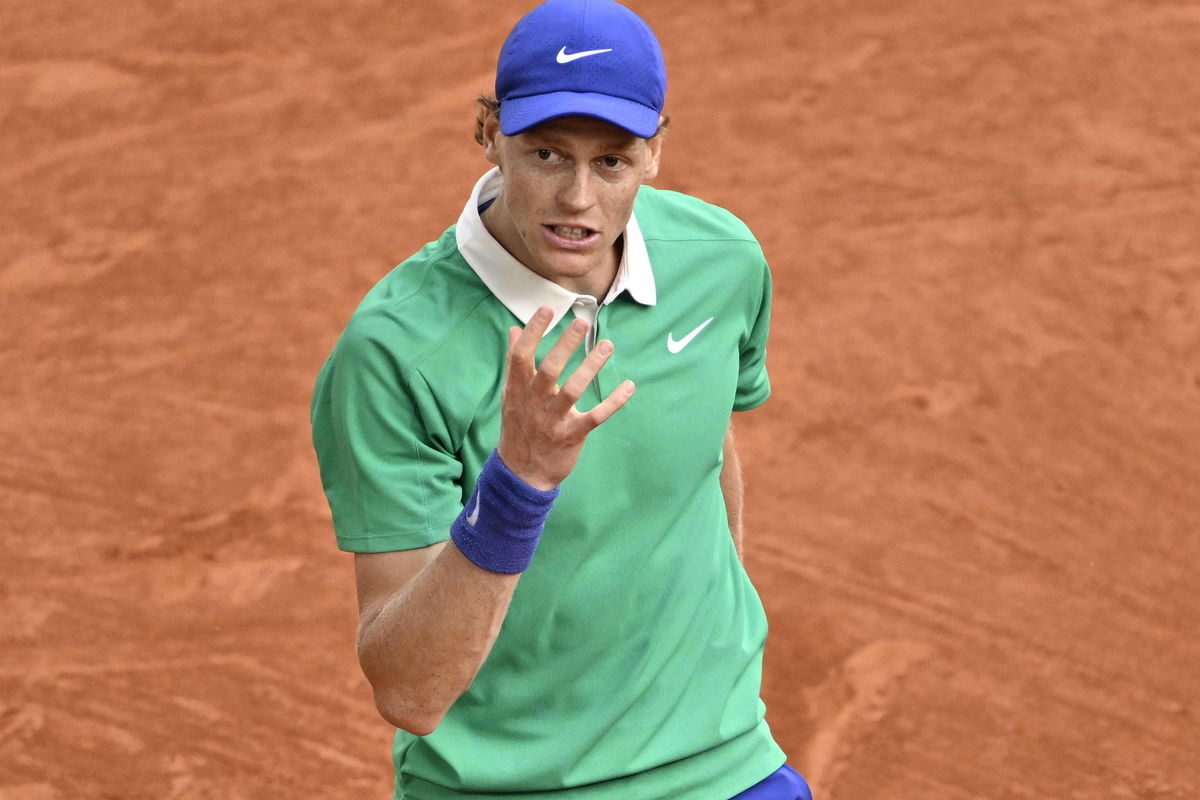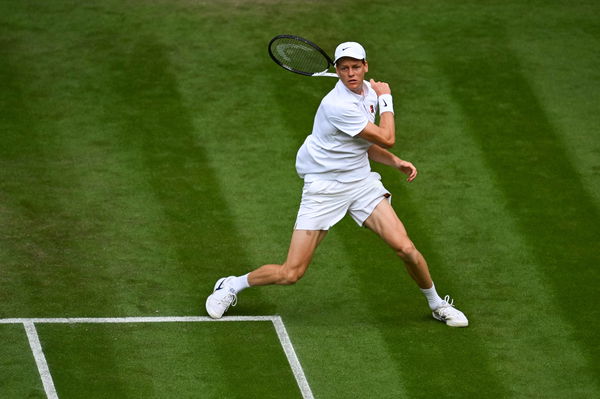
Imago
2025 Roland-Garros – Men s Single Final PARIS, FRANCE – JUNE 8: Jannik Sinner of Italy reacts as he competes against Carlos Alcaraz not seen of Spain during the Men s Single Final match on the day 15 of French Open tennis tournament on Court Philippe-Chatrier at the Roland-Garros Complex in Paris, France on June 8, 2025. Burak Akbulut / Anadolu Paris France. Editorial use only. Please get in touch for any other usage. PUBLICATIONxNOTxINxTURxUSAxCANxUKxJPNxITAxFRAxAUSxESPxBELxKORxRSAxHKGxNZL Copyright: x2025xAnadoluxBurakxAkbulutx

Imago
2025 Roland-Garros – Men s Single Final PARIS, FRANCE – JUNE 8: Jannik Sinner of Italy reacts as he competes against Carlos Alcaraz not seen of Spain during the Men s Single Final match on the day 15 of French Open tennis tournament on Court Philippe-Chatrier at the Roland-Garros Complex in Paris, France on June 8, 2025. Burak Akbulut / Anadolu Paris France. Editorial use only. Please get in touch for any other usage. PUBLICATIONxNOTxINxTURxUSAxCANxUKxJPNxITAxFRAxAUSxESPxBELxKORxRSAxHKGxNZL Copyright: x2025xAnadoluxBurakxAkbulutx
Jannik Sinner isn’t just the hottest name in tennis this summer—he’s rewriting the Wimbledon script with a brand of power and precision that feels tailor-made for Centre Court. The 23-year-old Italian star, now World No. 1, is in the midst of a career-defining run at SW19, showcasing not only his mental toughness but also a signature weapon that’s left opponents shaking their heads: his devastating forehand.
Watch What’s Trending Now!
Long known for his icy composure and complete game, Sinner has elevated his forehand to a level that’s dismantling even the best defenses on grass. It’s not simply about raw power—though he has plenty of that—but about the perfect fusion of technique, tactics, and mentality. Let’s break down why Jannik Sinner’s forehand is the shot everyone’s talking about at Wimbledon 2025.
ADVERTISEMENT
Jannik Sinner’s forehand technique: built for speed and precision
Sinner’s forehand isn’t just good—it’s a masterclass in modern technique. Despite his lean frame (around 1.91 m tall), he generates eye-popping pace and spin by leveraging excellent biomechanics. He uses a semi-western grip, a favorite among today’s baseliners, giving him the ability to strike with heavy topspin while flattening out shots when needed.
His swing mechanics are deceptively simple but lethal. Sinner has a relatively long backswing, but it remains low and compact, enabling him to handle fast, low grass-court balls. The magic happens in his uncoiling phase: he creates a huge unit turn, coiling his torso and hips like a spring. At contact, he releases all that stored energy with an explosive yet controlled whip of the racket, generating massive racket-head speed.
Top Stories
Novak Djokovic Makes a Bold Coaching Move As He Looks the Challenge Carlos Alcaraz & Jannik Sinner in 2026

Russian Tennis Hit Hard as Another WTA Player Forfeits Citizenship

Carlos Alcaraz and Jannik Sinner Take Bizarre On-Court Decision as Australian Open Countdown Begins

Aryna Sabalenka Breaks Silence on Nationality Switch After Belarus Representation Ban

WTA Player’s Misbehavior With Ball Kid Triggers Backlash From Former Tennis Pro

One thing that stands out is his timing. Sinner seems to meet the ball at the perfect moment nearly every time, taking it early and robbing opponents of time to react. This precise timing lets him redirect pace with ease and hit clean winners even off defensive positions. Add in his loose wrist and live elbow, and you have the recipe for a forehand that can go from heavy topspin rally shot to laser-like flat winner in an instant.
ADVERTISEMENT
How Jannik Sinner uses his forehand to dominate matches
Beyond technique, Sinner’s forehand is a tactical weapon that’s been central to his Wimbledon 2025 success. He uses it to dictate rallies, pushing opponents deep behind the baseline with relentless depth and spin. Grass courts reward aggressive play, and Sinner’s forehand is perfectly suited to exploit that.
ADVERTISEMENT
He’s also a master at changing direction. From the ad side, he can hook a cross-court forehand loaded with topspin, dragging opponents wide, then flatten out a down-the-line shot for the winner. Opponents know the patterns are coming but can’t stop them because of the sheer speed and precision of his strike.

Imago
2025 Wimbledon Jannik Sinner ITA 2025 Wimbledon *** 2025 Wimbledon Jannik Sinner ITA 2025 Wimbledon
Angles are another lethal part of his arsenal. On grass, with lower bounces and fast courts, Sinner uses his forehand to open up the court with acute angles, forcing errors or weak replies. This allows him to transition forward, where he’s increasingly confident finishing at the net.
ADVERTISEMENT
In Wimbledon 2025, you see him constructing points with patient aggression—using his forehand not just to hit winners but to wear opponents down. By mixing high, heavy topspin with flatter missiles, he keeps rivals guessing and off-balance. It’s a forehand that doesn’t just hit hard; it controls the chessboard.
Why Jannik Sinner’s forehand thrives under pressure
Perhaps the most impressive part of Sinner’s forehand this Wimbledon is how clutch it’s been in the big moments. Grass can be a nerve-wracking surface with its skids and bad bounces, but Sinner’s efficient mechanics hold up even when the pressure spikes.
ADVERTISEMENT
His composure is well documented: Sinner rarely shows panic on court, even in five-set battles. That calm translates directly to his forehand. Instead of tightening up, his loose, rhythmic swing lets him maintain racket-head speed under stress, avoiding the short balls and errors that creep in for so many players.
He also has the mental discipline to choose the right shot. Under pressure, he doesn’t just blast away mindlessly. He places the ball deep and heavy to gain control before going for the finishing blow. At Wimbledon 2025, he’s saved countless break points and closed out tight sets with forehands struck cleanly to the corners, showing not just physical skill but tactical maturity.
His belief in his technique allows him to swing freely even at 30–40 or in tiebreaks—a big reason he’s in the final at SW19 for the first time. For all the talk about his youth, it’s the blend of fearless aggression and icy shotmaking that has made his forehand one of the most feared weapons on tour.
ADVERTISEMENT
ADVERTISEMENT
ADVERTISEMENT
ADVERTISEMENT

